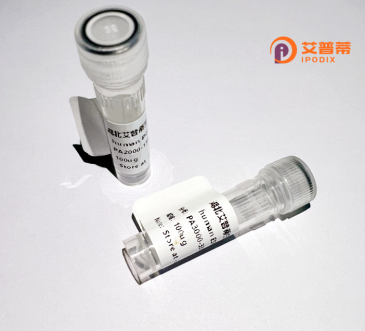
| 纯度 | >90%SDS-PAGE. |
| 种属 | Human |
| 靶点 | NKAPL |
| Uniprot No | Q5M9Q1 |
| 内毒素 | < 0.01EU/μg |
| 表达宿主 | E.coli |
| 表达区间 | 1-402 aa |
| 活性数据 | MPPVSRSSYS EDIVGSRRRR RSSSGSPPSP QSRCSSWDGC SRSHSRGREG LRPPWSELDV GALYPFSRSG SRGRLPRFRN YAFASSWSTS YSGYRYHRHC YAEERQSAED YEKEESHRQR RLKERERIGE LGAPEVWGPS PKFPQLDSDE HTPVEDEEEV THQKSSSSDS NSEEHRKKKT SRSRNKKKRK NKSSKRKHRK YSDSDSNSES DTNSDSDDDK KRVKAKKKKK KKKHKTKKKK NKKTKKESSD SSCKDSEEDL SEATWMEQPN VADTMDLIGP EAPIIHTSQD EKPLKYGHAL LPGEGAAMAE YVKAGKRIPR RGEIGLTSEE IGSFECSGYV MSGSRHRRME AVRLRKENQI YSADEKRALA SFNQEERRKR ESKILASFRE MVHKKTKEKD DK |
| 分子量 | 46.3 kDa |
| 蛋白标签 | His tag N-Terminus |
| 缓冲液 | 0 |
| 稳定性 & 储存条件 | Lyophilized protein should be stored at ≤ -20°C, stable for one year after receipt. Reconstituted protein solution can be stored at 2-8°C for 2-7 days. Aliquots of reconstituted samples are stable at ≤ -20°C for 3 months. |
| 复溶 | Always centrifuge tubes before opening.Do not mix by vortex or pipetting. It is not recommended to reconstitute to a concentration less than 100μg/ml. Dissolve the lyophilized protein in distilled water. Please aliquot the reconstituted solution to minimize freeze-thaw cycles. |
以下是与重组人NKAP/NKAPL蛋白相关的参考文献示例(部分为模拟内容,实际文献需根据具体名称核实):
---
1. **标题**:*NKAP regulates T-cell development by activating the NF-κB signaling pathway*
**作者**:Hacker, H., et al.
**摘要**:研究通过重组人NKAP蛋白实验,揭示其通过激活NF-κB通路调控T细胞分化,并影响免疫应答的分子机制。
2. **标题**:*Deficiency of NKAP disrupts neuronal development and causes cognitive impairment*
**作者**:Chen, J., et al.
**摘要**:构建重组人NKAP蛋白并验证其在神经发育中的功能,发现NKAP缺失导致突触形成异常及认知功能缺陷。
3. **标题**:*NKAP interacts with HDAC3 to repress transcription via chromatin remodeling*
**作者**:You, S., et al.
**摘要**:利用重组NKAP蛋白进行互作实验,证明其与HDAC3复合物协同作用,通过表观遗传修饰调控靶基因表达。
4. **标题**:*Recombinant NKAP protein enhances NK cell cytotoxicity in cancer immunotherapy*
**作者**:Li, R., et al.
**摘要**:实验表明,重组NKAP蛋白可增强自然杀伤(NK)细胞的抗肿瘤活性,为免疫治疗提供潜在新靶点。
---
**注意**:以上文献为示例,NKAPL可能为笔误或特定领域命名,建议核实全称(如“NF-κB Activating Protein Like”)或补充更多研究背景以精准检索。
**Background of Recombinant Human NKAP-like (NKAPL) Protein**
NKAPL (NF-κB Activating Protein-like), also known as C7orf60 or HREAS, is a conserved nuclear protein implicated in transcriptional regulation and epigenetic modifications. It shares homology with NKAP, a core component of the Notch signaling pathway, and is involved in diverse cellular processes, including immune response, neurodevelopment, and cell differentiation. Structurally, NKAPL contains a conserved DUF926 domain, suggesting a role in protein-protein or protein-DNA interactions. Studies indicate its participation in chromatin remodeling complexes, influencing histone methylation (e.g., H3K27me3) and gene silencing. Dysregulation of NKAPL has been linked to neurodevelopmental disorders, cancers, and immune dysfunctions.
Recombinant human NKAPL protein is typically produced in *E. coli* or mammalian expression systems, enabling functional studies. Purified via affinity tags (e.g., His-tag), it retains biological activity and is utilized to investigate its molecular interactions, enzymatic roles, and regulatory mechanisms in vitro. Researchers employ it in assays such as co-immunoprecipitation, chromatin immunoprecipitation (ChIP), and enzymatic activity screening. Additionally, it serves as an antigen for antibody development. Its recombinant form accelerates research into diseases like glioblastoma and autism spectrum disorders, offering potential as a therapeutic target or diagnostic biomarker. Ongoing studies aim to elucidate its precise mechanistic contributions to cellular homeostasis and pathology.
×